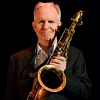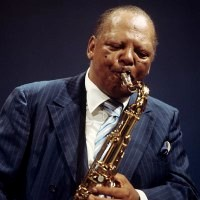Home » Jazz Musicians » Budd Johnson
Budd Johnson
One of the earliest Texas tenors, arranging boss of the Earl Hines Grand Terrace Orchestra, and pivotal swing-to-bop figure, Budd Johnson distributed his gifts through several eras of jazz. He was a major composer and arranger and a saxophonist whose style fit as comfortably into bebop as it did into swing. Albert J. (Budd) Johnson was born in Dallas on December 14, 1910. His father was a choir director and cornetist who taught him piano at a young age. By Johnson's teenage years he had switched to drums and was playing with his brother, Keg Johnson, in bands around town. Eventually the two started their own group, the Moonlight Melody Six. They later joined Gene Coy's Amarillo-based band, the Happy Black Aces. Switching instruments again, this time to the saxophone, Johnson headed to Kansas City and then to Chicago, where he met and joined Louis Armstrong in 1933. During his stint in the Windy City he also met Earl Hines; their musical relationship lasted nine years. It was during his tenure with Hines that he came into his own as an arranger on top of being a solid member of the reed section. By 1944 Johnson had moved to New York City, where he became involved in organizing and playing in smaller jazz combos, joining up with Coleman Hawkins, Dizzy Gillespie, Woody Herman, and Billy Eckstine, in whose band he replaced Dexter Gordon. Johnson became a pioneer of the emerging bop jazz style, and he is credited with organizing the first bop recording session. He remained an integral part of American jazz throughout the 1950s. In 1956-57 he played with Benny Goodman, with whom he toured Asia, and in 1958 he formed his own septet and recorded the album “Blues a la Mode.” In 1960 he did a stellar session “Budd Johnson and the Four Brass Giants,” for Riverside. Johnson, who takes tenor solos throughout the date and also contributes a bit of clarinet in addition to providing the arrangements, is matched with four distinctive and very different trumpeters: Clark Terry, Harry "Sweets" Edison, Nat Adderley and Ray Nance. He seemed in top form that year (’60) for he also did “Let’s Swing,” which is regarded as one of his best efforts. He would go on to be involved in countless of sessions and too many recording to mention. During the 1960s Johnson played with Count Basie and Quincy Jones and rejoined Earl Hines in ’64.
Read moreTags
Various Artists: The Birth of Bop

by Richard J Salvucci
Someone famously called jazz the sound of surprise, but all too often, what is on offer is the dull hum of routine. Or something like that. This historic reissue is, however, anything but routine. This is not the first time that Teddy Reig's Savoy sides have been reissued (was he also the mysterious Buck Ram listed as producing one track?), but Craft Recordings took a lot of trouble to produce this very fine selection. If a listener were, ...
Continue ReadingBudd Johnson: and the Four Brass Giants

by Derek Taylor
Put simply and succinctly this is a brass lover’s dream! The fact that you get the hard swinging and under-recognized Budd Johnson as part of the package makes it damn near essential. Originally the brainchild of Nat Adderly’s brother (“Cannonball” anyone?), Johnson took the arranger’s helm at an early stage of the project and devised a program of tunes with the preeminent four-pronged phalanx of soloists squarely in mind. He succeeds superlatively with an exciting blend of standards and originals ...
Continue ReadingBudd Johnson: Let's Swing!

Source:
JazzWax by Marc Myers
I'm not sure why tenor saxophonist Budd Johnson didn't record more often as a leader. I suspect the reason rests with his enormously busy sideman schedule. Johnson appeared onnearly 400 recording sessions over the course of his career. In addition, he was likely more comfortable at top man in a reed section than standing front and center blowing, given that he wasn't particularly distinct as a soloist, like Gene Ammons, Ben Webster or Lester Young. One of Johnson's finest sessions as ...
read more
































